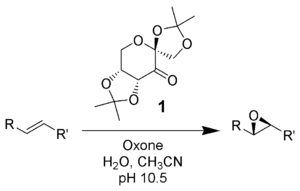Potassium peroxymonosulfate
 | |
| Names | |
|---|---|
| IUPAC name Potassium peroxysulfate | |
| Other names | |
| Identifiers | |
CAS Number |
|
3D model (JSmol) |
|
| ChemSpider |
|
| ECHA InfoCard | 100.030.158 |
PubChem CID |
|
| UNII |
|
CompTox Dashboard (EPA) |
|
InChI
| |
| |
| Properties | |
Chemical formula | KHSO5 |
| Molar mass | 152.2 g/mol (614.76 g/mol as triple salt) |
| Appearance | Off-white powder |
Solubility in water | Decomposes |
| Hazards | |
| Occupational safety and health (OHS/OSH): | |
Main hazards | Oxidant, corrosive |
| NFPA 704 (fire diamond) |  3 0 1 |
| Safety data sheet (SDS) | Degussa Caroat MSDS |
| Related compounds | |
Related compounds | Potassium persulfate |
Except where otherwise noted, data are given for materials in their standard state (at 25 °C [77 °F], 100 kPa).  N verify (what is N verify (what is  Y Y N ?) N ?) Infobox references | |
Potassium peroxymonosulfate is widely used as an oxidizing agent, for example, in pools and spas (usually referred to as monopersulfate or "MPS"). It is the potassium salt of peroxymonosulfuric acid. Usually potassium peroxymonosulfate is available as the triple salt 2KHSO5·KHSO4·K2SO4, known as Oxone.
The standard electrode potential for potassium peroxymonosulfate is +1.81 V with a half reaction generating the hydrogen sulfate (pH = 0):[4]
- HSO−5 + 2H+ + 2e− → HSO−4 + H2O
Oxone
Potassium peroxymonosulfate per se is a relatively obscure salt, but its derivative called Oxone is of commercial value. Oxone refers to the triple salt 2KHSO5·KHSO4·K2SO4. Oxone has a longer shelf life than does potassium peroxymonosulfate. A white, water-soluble solid, Oxone loses <1% of its oxidizing power per month.[5]
Production
Oxone is produced from peroxysulfuric acid, which is generated in situ by combining oleum and hydrogen peroxide. Careful neutralization of this solution with potassium hydroxide allows the crystallization of the triple salt.
Uses
Cleaning
Oxone is used widely for cleaning. It whitens dentures,[6] oxidizes organic contaminants in swimming pools,[citation needed] and cleans chips for the manufacture of microelectronics.[6][7][8]
Organic chemistry
Oxone is a versatile oxidant in organic synthesis. It oxidizes aldehydes to carboxylic acids; in the presence of alcoholic solvents, the esters may be obtained.[9] Internal alkenes may be cleaved to two carboxylic acids (see below), while terminal alkenes may be epoxidized. Sulfides give sulfones, tertiary amines give amine oxides, and phosphines give phosphine oxides.
Further illustrative of the oxidative power of this salt is the conversion of an acridine derivative to the corresponding acridine-N-oxide.[10]

Oxone oxidizes sulfides to sulfoxides and then to sulfones.[11]

Oxone converts ketones to dioxiranes. The synthesis of dimethyldioxirane (DMDO) from acetone is representative. Dioxiranes are versatile oxidising agents and may be used for the epoxidation of olefins. In particular, if the starting ketone is chiral then the epoxide may be generated enantioselectively, which forms the basis of the Shi epoxidation.[12]

References
- ^ Wu, Mingsong; Xu, Xinyang; Xu, Xun (November 2014). "Algicidal and Bactericidal Effect of Potassium Monopersulfate Compound on Eutrophic Water". Applied Mechanics and Materials. 707: 259. doi:10.4028/www.scientific.net/AMM.707.259. S2CID 98000605.
- ^ Pool School. Trouble Free Pool. p. PT4. Retrieved November 30, 2018.
- ^ "DuPont MSDS" (PDF). Archived from the original (PDF) on 2014-08-15. Retrieved 2012-01-26.
- ^ Spiro, M. (1979). "The standard potential of the peroxosulphate/sulphate couple". Electrochimica Acta. 24 (3): 313–314. doi:10.1016/0013-4686(79)85051-3. ISSN 0013-4686.
- ^ Crandall, Jack K.; Shi, Yian; Burke, Christopher P.; Buckley, Benjamin R. (2001). Encyclopedia of Reagents for Organic Synthesis. John Wiley & Sons, Ltd. doi:10.1002/047084289x.rp246.pub3. ISBN 978-0-470-84289-8.
- ^ a b Harald Jakob; Stefan Leininger; Thomas Lehmann; Sylvia Jacobi; Sven Gutewort. "Peroxo Compounds, Inorganic". Ullmann's Encyclopedia of Industrial Chemistry. Weinheim: Wiley-VCH. doi:10.1002/14356007.a19_177.pub2. ISBN 978-3527306732.
- ^ Peroxy Compounds Human Health and Ecological Draft Risk Assessment DP 455445, 455446 (Report). United States Environmental Protection Agency. 2020-03-11. p. 9-10. Retrieved 2021-09-24.
- ^ Wacławek, Stanisław; Lutze, Holger V.; Grübel, Klaudiusz; Padil, Vinod V.T.; Černík, Miroslav; Dionysiou, Dionysios. D. (2017-12-15). "Peroxy Compounds Human Health and Ecological Draft Risk Assessment DP 455445, 455446". Chemical Engineering Journal. 330: 44–62. doi:10.1016/j.cej.2017.07.132.
- ^ Benjamin R. Travis; Meenakshi Sivakumar; G. Olatunji Hollist & Babak Borhan (2003). "Facile Oxidation of Aldehydes to Acids and Esters with Oxone". Organic Letters. 5 (7): 1031–4. doi:10.1021/ol0340078. PMID 12659566.
- ^ Bell, Thomas W.; Cho, Young-Moon; Firestone, Albert; Healy, Karin; Liu, Jia; Ludwig, Richard; Rothenberger, Scott D. (1990). "9-n-Butyl-1,2,3,4,5,6,7,8-Octahydroacridin-4-ol". Organic Syntheses. 69: 226. doi:10.15227/orgsyn.069.0226.
- ^ McCarthy, James R.; Matthews, Donald P.; P. Paolini, John (1995). "Reaction of Sulfoxides with Diethylaminosulfur Trifluoride". Organic Syntheses. 72: 209. doi:10.15227/orgsyn.072.0209.
- ^ Frohn, Michael; Shi, Yian (2000). "Chiral Ketone-Catalyzed Asymmetric Epoxidation of Olefins". Synthesis. 2000 (14): 1979–2000. doi:10.1055/s-2000-8715.
- v
- t
- e
- K3N
- KNH2
- KN3
- KNO2
- KNO3
- K3P
- KH2PO3
- K3PO4
- K2HPO4
- KH2PO4
- KPF6
- KAsO2
- K3AsO4
- K2HAsO4
- KH2AsO4
- B4K2O7
- K2CO3
- KHCO3
- K2SiO3
- K2SiF6
- K2Al2O4
- K2Al2B2O7
- K2PtCl4
- K2Pt(CN)4
- K2TiF6
- K2PtCl6
- K2ReCl6
- KAsF6
- K2ZrF6
- K4Fe(CN)6
- K3Fe(CN)6
- K3Fe(C2O4)3
- K2FeO4
- K2MnO4
- KMnO4
- K3CrO4
- K2CrO4
- K3CrO8
- KCrO3Cl
- K2Cr2O7
- K2Cr3O10
- K2Cr4O13
- K4Mo2Cl8
- KHCO2
- KCH3CO2
- KCF3CO2
- K2C2O4
- KHC2O4
- KC12H23O2
- KC18H35O2
- C3H2K2O4
- C4H6KO4
- C5H7KO4











